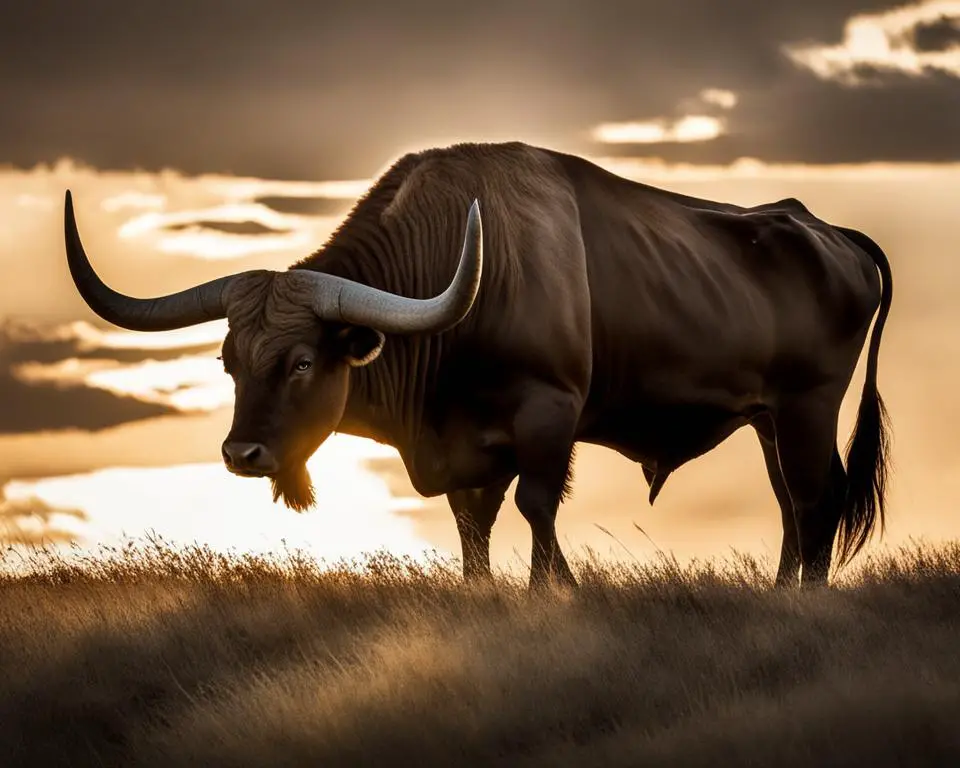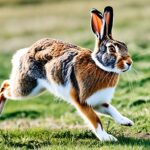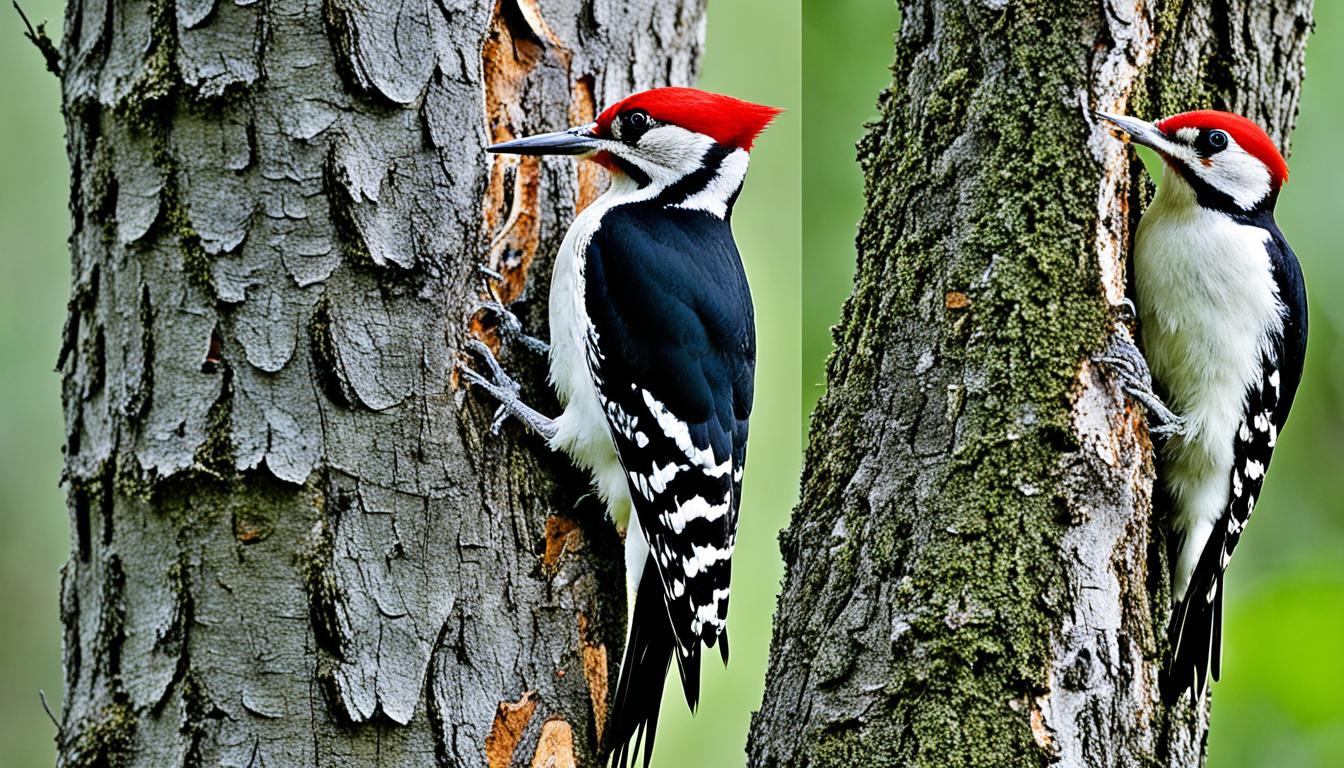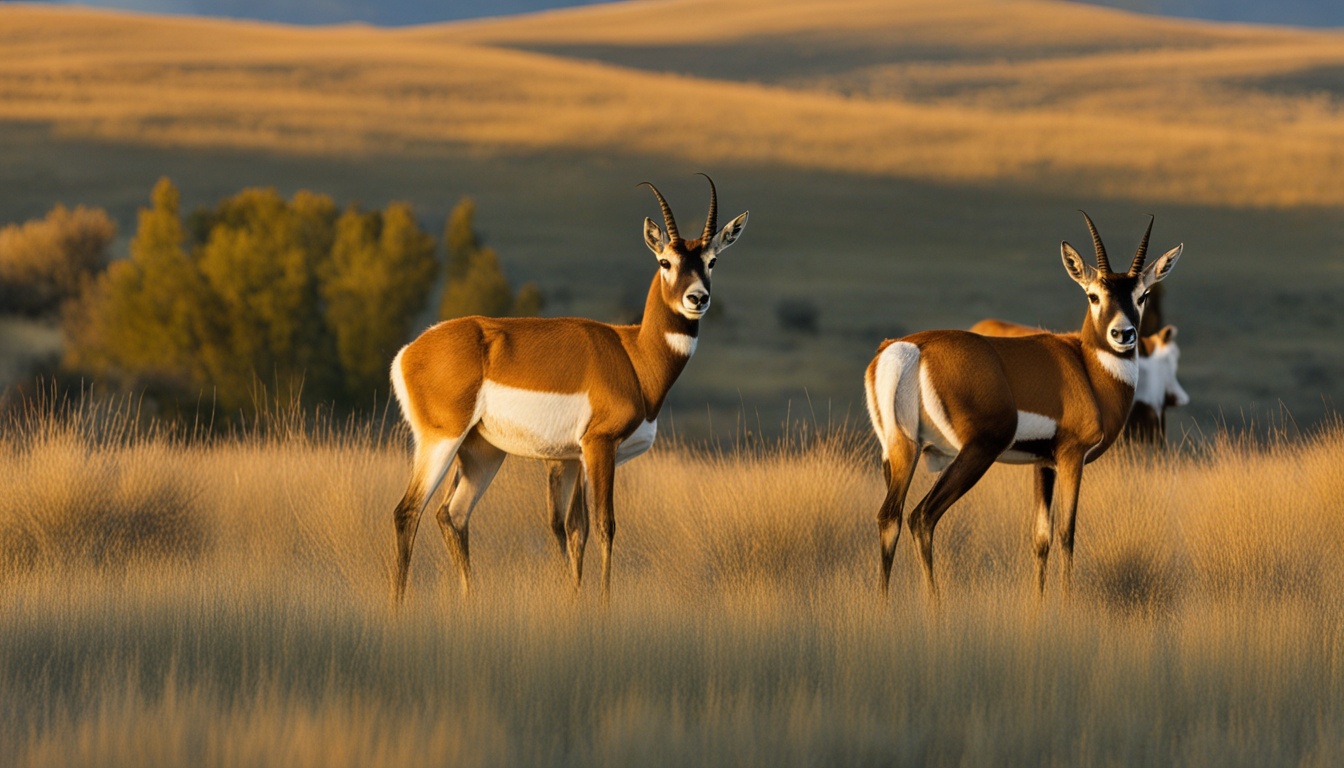Embark on a journey into the fascinating world of bulls, where interesting bull trivia and astonishing bull facts await you. As commanding members of the bovine family, bulls have long stood as powerful emblems across various cultures and civilizations, carrying profound bull symbolic meaning and showcasing captivating bull behavior. Whether in the tapestry of agriculture or the arena of cultural festivities, these magnificent creatures continue to charm and amaze. So, let’s dive into the realm where strength meets intelligence, uncovering the extraordinary nature of bulls.
In this section, you’ll discover why bulls have been venerated as symbols of virility and courage, and how their remarkable roles in both nature and human-made traditions reveal their true significance. Prepare to be intrigued by the secrets and insights that define these noble animals.
Ancestry and Family: Understanding Bovine Relationships
When you delve into the intricate world of bovine family connections, you’ll find that the bull’s ancestry is deeply rooted in a diverse group of animals, including cows and oxen. Within this family tree, an array of cattle breeds emerges, each with unique characteristics that prove essential for various human endeavors.
Let’s consider the broad tapestry of bovine relatives, starting with the storied bull ancestry. These creatures are not only formidable in their presence but also bring a multitude of attributes to their environments and to the cultures that surround them.
| Breed | Traits | Usefulness | Cultural Significance |
|---|---|---|---|
| Spanish Fighting Bull | Aggressive, muscular | Bullfighting, showcasing virility | Symbol of Spanish heritage and bravery |
| Scottish Highland Bull | Gentle, long-haired | Meat production, landscape grazing | Icon of Scottish tradition and resilience |
| Angus | Polled, well-marbled beef | Beef production | Renowned worldwide for quality meat |
| Hereford | Hardy, good-natured | Beef and working cattle | Depicted as the epitome of rural life |
As you can see, the cow and oxen relatives, spanning continents and histories, present a kaleidoscope of bovine evolution. In some regions, “Mickey” refers to an uncontrolled bull in Australia, while “bullock” may refer to a young bull in North America, illustrating the rich nomenclature that reflects both their reproductive roles and hierarchical statuses.
Understanding the genealogy of bulls gives you insight into their role in agriculture, their influence on cultural narratives, and ultimately, their significance in the broader scope of animal husbandry. As we continue to explore these beings, remember that the lineage of the bovine family encompasses a fascinating blend of brute power and tender care, shaping the landscapes they inhabit and the lives of those who depend on them.
The Strength of a Bull: Measuring Their Power
Discover the sheer bull strength that propels these majestic creatures to a status of reverence, particularly in the agricultural world where they are seen as tireless workers. Beyond their brute force, the muscular build of a bull is a marvel in its own right, sculpted by nature to provide the bovine power necessary for enduring the demands of farm life and beyond.
Bulls in Agriculture: Tireless Workers
Your understanding of agricultural bulls must begin with their indispensable role on farms across the globe. From dawn till dusk, these powerful animals contribute significantly to the agricultural industry, using their considerable strength to plow fields and tow heavy loads with seemingly effortless endurance. This strength not only epitomizes the utility of bulls in farming tasks but also speaks to the harmonious relationship between humankind and animal, cultivated over thousands of years.
Unmistakable Silhouettes: A Bull’s Muscular Build
The distinct silhouette of a bull is a testament to its raw power and resilient physiology. With thick bones and large, muscular necks, these beasts boast a significant bone mass and a pronounced hump on their shoulders. This unique muscular build is not just for show; it serves as a vital asset in the bull’s daily endeavors, be it dominating their habitat or showcasing their might in the fields. The bovine power of these animals heralds their status as unparalleled agricultural assets and symbols of enduring stamina.
| Breed | Weight Range | Agricultural Uses | Physical Traits |
|---|---|---|---|
| Charolais | 2,000 to 2,500 lbs | Plowing, Breeding | Heavy muscling, White coat, Deep body |
| Limousin | 1,800 to 2,300 lbs | Meat Production, Draft Work | Lean physique, Light golden-red color |
| Brahman | 1,600 to 2,200 lbs | Field Grazing, Breeding | Large hump, Loose, pendulous skin |
| Angus | 1,800 to 2,000 lbs | Beef Production | Polled, Solid black or red, Excellent marbling |
In your encounters with these animals, it becomes evident that their physical aptitude is intrinsically designed for thriving amidst the rigors of farm life, all the while advancing our agricultural pursuits. Through the vast expanses of farmland to the intimate barnyard settings, bulls channel their intrinsic bovine vigor into the very fabric of agrarian society.
Symbolism in Cultures: Bulls as Icons of Might
Across civilizations, bull symbolism has been deeply etched into the cultural consciousness, with bulls representing formidable forces of strength, power, and fertility. These majestic animals bear the weight of significant cultural narratives, woven into the tapestry of human history. As cultural icons, they not only signify the raw physical power but also profound spiritual energy.
From the celestial bulls in mythology that dot our ancient skies in the constellation of Taurus to their earthly counterparts who carry gods across mythic landscapes in Hindu stories, these animals’ bovine significance is unmatched. Bulls serve as fascinating subjects in artwork and are central figures in rituals and celebrations, embodying traits humans have revered since time immemorial.
In the narrative tapestry of global cultures, bulls abound with meaning. For instance, the bull is an esteemed figure in Hindu mythology, serving as Nandi, the calm yet powerful vehicle for Lord Shiva. Such depictions underscore the bull’s dichotomy – a powerful beast capable of rage yet equally associated with piety and calmness.
Delving into earliest human expressions, we discover ancient cave paintings where bulls were rendered with admiration and awe, capturing their vital essence for prosperity and survival. The aura of bull symbolism further reaches back to ancient civilizations like that of Sumer, where the ‘Bull of Heaven’ in the Epic of Gilgamesh symbolized divine intervention and ultimate sacrifice.
Likewise, the bull’s role in culture is ever-present today. Be it in vigorous festivals or serene religious practices, the essence of the bull continues to be celebrated:
| Culture | Symbolic Trait | Manifestation |
|---|---|---|
| Greek | Virility and determination | The Minotaur legend, symbolizing both menace and might. |
| Spanish | Bravery and endurance | The San Fermín festival, demonstrating both human and bovine courage. |
| Hindu | Serenity and strength | Worship of Nandi, reflecting the respect for both calm and raw power. |
| Ancient Sumerian | Divine force and sacrifice | The ‘Bull of Heaven’ in the Epic of Gilgamesh, embodying celestial might. |
Your recognition of these cultural icons allows you to see beyond the physical to the myriad of roles that bulls fulfilled and continue to maintain in the human story. Their place in the firmament of our shared heritage is substantial, with each narrative and depiction contributing to the layered tapestry of bull symbolism that still captures our collective imagination.
Bulls Across the Globe: Different Breeds and Characteristics
As you explore the world of bulls, it’s fascinating to observe the incredible bull diversity that thrives across varying climates and continents. Global bull breeds showcase an array of breed traits that not only signify their adaptability but also their specialized roles in human life. Each breed, from the robust Chianina to the hardy Scottish Highland, is a product of careful selection, rendering them ideally suited to their specific environments and the demands placed upon them.
Let’s take a closer look at how these breeds exhibit their unique characteristics and their impressive adaptation strategies, making each of them invaluable to the regions they inhabit and to the agricultural practices that rely on them:
| Breed | Origin | Typical Traits | Human Use | Adaptation |
|---|---|---|---|---|
| Chianina | Italy | Large size, white coat | Draft work, high-quality beef | Heat tolerance, strong constitution |
| Scottish Highland | Scotland | Long hair, sturdy frame | Beef production, grazing | Cold weather resilience |
| Angus | Scotland | Naturally polled, marbled beef | Premium beef production | Adaptable to varied climates |
| Jersey | Jersey, UK | Small size, high butterfat milk | Dairy production | Efficient feed converters |
| Brahman | India | Distinctive hump, loose skin | Meat, crossbreeding for vigor | Resistance to pests, heat tolerance |
From the meat-lover’s prized Angus to the dairy farmer’s cherished Jersey, each bull breed possesses qualities that result from centuries of selective breeding. Reflecting on these breeds, you can see how humans have shaped the bovine family to suit our needs, from luxurious dairy products to robust and tender meats, while also ensuring these creatures thrive in their respective domains.
Beyond mere utility, the presence of these animals enriches cultural identities—picture the iconic Chianina in the rolling hills of Tuscany or the Scottish Highland enduring the mists of the Highlands. They are as much a part of the landscape as the people themselves, deeply intertwined with the fabric of local heritage.
In summary, the world’s bull breeds reflect a story of successful adaptation and purpose-driven enhancement. Next time you come across a bull, pause to marvel at its evolution from ancient wild ox to today’s modern bovine marvels, perfectly poised in both form and function.
Majestic Horns: More Than Just a Weapon
Delve into the remarkable world of horned cattle, where bull horns stand as emblems of resilience and authority. But these majestic appendages are much more than mere combat tools. They reflect a bull’s might, serve as pivotal assets in their defense mechanisms, and are integral to the dominance displays in the pasture’s social theater.
Why Horns Matter: Defense and Dominance
For horned cattle, their horns are a critical part of their anatomy, serving dual and equally vital roles in defense and social dominance. When faced with predators, a bull’s horns are formidable weapons, capable of inflicting serious wounds to deter any threats to their well-being or that of the herd. These defense mechanisms are a natural form of protection, deeply ingrained in the biology and behavior of these animals.
In addition to safeguarding against predators, bull horns are tools of discourse in the social realm of bovine life. Hierarchies within herds are often established and maintained through shows of strength and power, where the prominent horns play a central role. They are wielded in bouts of wrestling and head-butting, where bulls assert their dominance, securing their rank and mating rights.
Horn Variations Among Breeds
Within the diverse world of horned cattle, you’ll find a fascinating array of breed-specific horns. From the stately upwards arch of the Texas Longhorn to the pronounced, outward sweep of the Ankole-Watusi, horn shapes and sizes are as varied as the breeds themselves. This spectrum of horn styles is a testament to the breadth of bovine biodiversity.
Moreover, selective breeding practices have shaped the characteristics of horns in countless cattle breeds. Some have been bred for larger, more intimidating horns, while others have had their horn growth regulated through practices like disbudding, to mitigate risks associated with horned animals in agricultural settings.
Examining these variations gives a deeper understanding of how each breed has evolved or been developed for certain environments and tasks. The majestic adornments that crown their heads are not just a hallmark of the animals’ inherent grandeur but also a reflection of human influence on the natural world.
The union of strength and utility encapsulated in a bull’s horns endows these creatures with a silent, yet resounding presence. As you observe the robust curves of a Charolais or the sharp points of a Highland, consider the heritage and selective craft that have etched such grandeur into the profile of these pastoral giants.
Playful Giants: The Misunderstood Nature of Bulls
When you observe the robust and majestic bulls in pastures or on farms, your initial impression may be shaped by their imposing size and seemingly stern demeanor. Yet, there’s more to bull behavior than meets the eye. Behind this facade lies a playful nature, notably evident in youthful bulls who have yet to take on the full mantle of herd protectors. These massive creatures, despite their powerful presence, take part in bouts of animal play that may surprise those unfamiliar with their kind-hearted shenanigans.
Among bulls, especially the younger ones, play-fighting stands out as a common and endearing activity. These mock battles, featuring head-butting and light sparring, are not rooted in aggression but rather in camaraderie and learning. This playful nature is crucial for their development, as it helps them establish social bonds with their fellow bovines and refine the skills needed for future interactions as they mature within their close-knit communities.
| Age Group | Types of Play | Benefits |
|---|---|---|
| Youthful Bulls | Sparring, Jumping, Running | Skill Development, Social Bonding |
| Adult Bulls | Head-Butting, Mock Fights | Dominance Establishment, Physical Conditioning |
| Aged Bulls | Less frequent play | Maintenance of Social Status, Mental Stimulation |
The playful behavior of bulls is not exclusive to their interactions with other cattle. You may also witness these sentient beings engaging with their environment in ways that exhibit their curiosity and zest for life. Whether it’s frolicking across a field, playfully tossing objects with their horns, or responding to humans with gentle nudges, there’s a mischievousness that breaks through the stereotype of the stern bull.
As you spend time with these magnificent giants, take a moment to appreciate the lighter and softer side of bull behavior. These instances of animal play are not just amusing; they remind us that within these powerful creatures lies a spirit of joy and a capacity for gentle interaction.
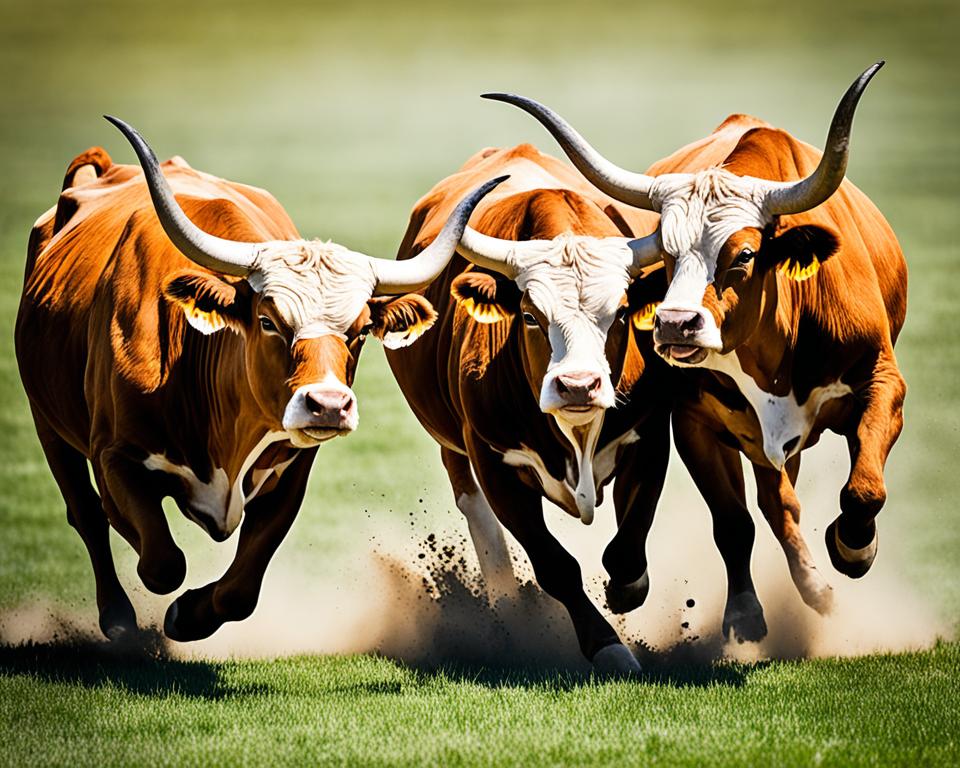
While the sight of bulls charging might evoke feelings of awe, their at-ease frolicking and tender moments with each other highlight an aspect of their nature that’s often overlooked. The fascinating duality of the bull—both a regal guardian and a light-hearted player—provides a deeper understanding of these compelling animals and their place in the complex tapestry of life.
Sensory Powerhouses: How Bulls Perceive Their World
Imagine walking through the countryside and observing a bull in its natural habitat. It might appear that these bovine giants are just passively grazing, but in reality, their senses are acutely tuned to their environment. Bulls, armed with keen hearing and a robust olfactory system, are sensory powerhouses. These capabilities not only enhance their interaction with the world but also contribute significantly to their survival instincts.
The Acute Hearing of Bulls
Ever wondered how bulls can be so responsive to their surroundings? One secret lies in their remarkably keen hearing. These animals can pick up on the slightest rustling of grass or the distant call of a herd mate. This auditory sensitivity allows bulls to communicate effectively over large pastures and to be aware of approaching predators or humans, long before they pose a threat.
A Keen Sense of Smell for Survival
The olfactory system of a bull is another marvel, intricately woven into their very being for survival. A bull can scent water sources from miles away, detect the nuanced smells of various plants to decide on their next meal, and, perhaps most impressively, can sense pheromones from a potential mate during mating season. All these olfactory abilities are vital to the perpetuation of their species and the avoidance of dangers.
In essence, the complex sensory world of bulls is a fundamental aspect of their existence. It influences their decisions, from finding nourishment to safeguarding their herd, thus asserting their place as formidable yet perceptive beings in the animal kingdom.
Bulls in Motion: Surprising Athletic Abilities
Have you observed the impressive way bulls move within their domain? Not only do these magnificent creatures showcase impressive bull athleticism, they also exhibit surprising speed and agile movements that are nothing short of extraordinary for their size. These qualities not only amplify their stunning nature but also reflect their intrinsic athletic prowess. Let’s examine the finesse with which bulls navigate their spaces, transforming our perception of these bovine athletes.
Sprinters of the Pasture: Bull Speed and Agility
When we think of bulls, their bulk might imply a sluggish gait, yet their running speed tells a different tale. Capable of expedient sprints, bulls can charge with the agility of seasoned athletes. In the open fields, they’re known to reach speeds rivaling that of a fast gallop. This burst of speed, reaching up to 35 miles per hour, serves as a remarkable display of their survival instincts and offers an extraordinary spectacle during cultural events that celebrate their vigor and vitality.
The Elegance of a Bull’s Movements
Beyond their rapid sprints, bulls partake in an array of movements demonstrating the elegance of their species. Their capacity for agile movement is often observed in the fluidity of their turns and the astonishing jumps they perform when instigated to action. The grace with which these colossal animals maneuver through their environment is a testament to the evolved anatomy that supports their rich history of both work and ceremonial pastimes.
Your appreciation for the bull’s agility may deepen as you consider the complex interaction of muscle and sinew that propels these creatures into motion. Whether it’s during the excitement of a bull riding event or the tradition-entrenched bullfighting, their swift responsive actions uphold their reputation as true athletes of the animal kingdom. Their natural athletic abilities are an essential aspect of their survival and the continuation of the species.
Indeed, when we witness their powerful legs driving them forward across the pasture, or their nimble pivots as they navigate obstacles, we are witnessing the culmination of millennia of athletic evolution. The next time you encounter these beasts, whether on a farm or at an event, take a moment to marvel at the spectacle of bull athleticism — a true confluence of power, grace, and survival instinct.
Fun Facts About Bulls: Revelations of Magnificence
As you immerse yourself in the extraordinary world of bulls, their undeniable cultural impact and the plethora of bull facts stands as a true testament to their influence across the tapestry of human history. From the ancient walls of Minoan palaces to the vibrant streets of Pamplona, these magnificent bovine creatures have long been woven into human narrative, holding a mirror to our ancestry and revealing an astonishing anthropogenic connection.
The Impact of Bulls on Human Society
You’re likely familiar with the iconic scenes of bullfighting or the thrill-seeking tradition of Running with the Bulls. These events are but a fraction of the practices that demonstrate the deep-seated reverence for and anthropogenic connection with bulls. The rituals and ceremonies that have evolved around these animals underline their status as potent symbols in diverse cultural milieus. By drawing from tales where bulls are valiant figures, societies have continually echoed the values of valiance and vigor.
Unexpected Behaviors: A Glimpse into Their World
The bulls’ presence has not only spurred humans into communal expressions of bravery and festivity but has also offered intimate glimpses into the bovine behaviors that challenge common misconceptions. From contemplative moments of serenity as they graze the field to the sudden eruption of energy propelling them into powerful sprints, the daylight-to-dusk life of a bull is filled with contrasts and whispers of an untamed heritage.
As you venture further into understanding these creatures, it dawns on you that every snort, every stomp, and every playful jostle is richly layered in meaning—silhouettes of their wild origins and the subtle interplay with their domesticated world. Observing them is watching a history of human-animal relationships unfold, a unique dance that is both ancient and renewed with each generation.
Next time you come across these majestic beings, remember the role they play in enriching our societies and contributing to our shared narratives. Remember too the simplicity in their complex nature, the unspoken conversations carried on the breeze, and the enchanting beauty held within their myriad of behaviors.
Bulls in Sports and Festivities: A Test of Bravery
The thunderous applause in stadiums and the thrilling cheers in the streets during cultural festivities often accompany the exhilarating and time-honored practices involving bulls. These majestic animals play a pivotal role in various bull sports, where they not only showcase their raw power but also serve as a bravery test for those who dare to engage with them. Such events are deeply rooted in tradition and continue to capture the excitement of participants and spectators alike.
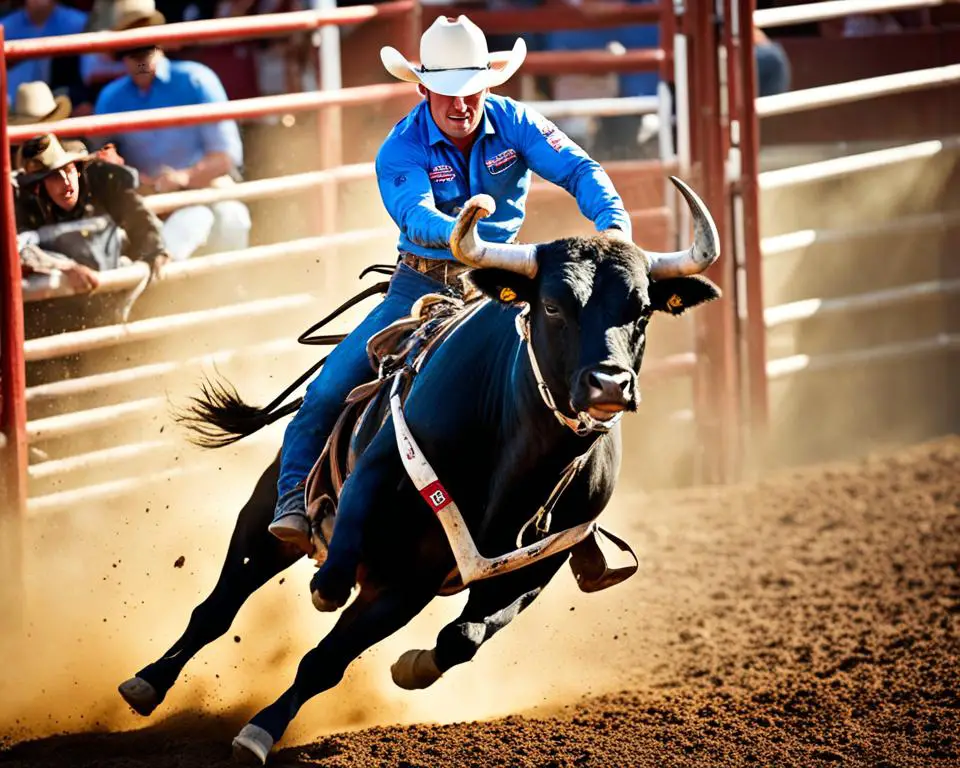
Among these captivating events, bull riding emerges as a prominent sport in the United States, where cowboys endeavor to maintain their balance atop a bucking bull for a heart-stopping eight seconds. This high-adrenaline sport is not only a spectacle of human determination but also a testament to the athletic prowess of the bulls themselves, as they become the centerpieces of these dynamic events.
In addition to the electric atmosphere of the bull riding arena, another cultural phenomenon that brings together the essence of courage and tradition is the famous Running of the Bulls. Originating from Spain and gaining international fame, particularly through the annual celebration in Pamplona, this event sees participants racing in front of a herd of running bulls, an act that epitomizes the ultimate bravery test.
While the participation in these cultural festivities reflects a rich tapestry of heritage and communal valor, it is essential to recognize the debate surrounding bull sports. Bullfighting, in particular, faces scrutiny for its impact on animal welfare. Still, within the bounds of cultural context, it remains a deeply ingrained tradition in several parts of the world, with matadors and spectators alike drawn to the ancient dance between man and beast.
Whether it’s the modern-day rodeo enthusiast or the traditional bullfighting aficionado, the common thread binding these events is the compelling interplay of fearlessness and respect for the formidable nature of bulls. As you witness the sheer strength and agility on display, you become part of a legacy celebrating the profound connection between humans and these valiant, four-legged titans of the animal kingdom.
The Social Lives of Bulls: Hierarchies and Herd Dynamics
As you step into the realm of bovine sociology, it becomes clear that the bull social structure is not random chaos but rather a sophisticated system of order and dominance. Like many social animals, bulls engage in complex interactions that maintain balance and cohesion within the herd. The intricate herd hierarchies are a ballet of power, purpose, and protection, with each member playing a vital role.
At the center of this structured world is the dominant bull, whose role is more than just symbolic—he is the leader, the guardian, the triumph of brute strength guided by deep-seated animal instincts. This strong leadership is imperative for the safety and survival of the group, and is often challenged by younger, ambitious bulls aiming to establish their own dominance. Such displays of power are an essential part of animal comportment, evident in how each member respects the established hierarchy, ensuring herd stability.
The ways in which these hierarchies are maintained is a study in nonverbal eloquence. Bulls communicate firmly through a variety of channels:
- Vocalizations: A bull’s bellow is not just a sound that permeates the air; it’s a proclamation of presence, an announcement of hierarchy, and a call that can signify anything from a warning to a welcome.
- Body Language: Posture and movement carry weight in bovine society, where the tilt of a head or the stamp of a foot speaks volumes about intentions and emotions.
- Scent Marking: As much a part of their dialogue as any sound, the scent left by a bull is his signature, an invisible yet indelible mark on his environment and his herd.
This rich tapestry of interaction isn’t mere animal behavior but a language that is as nuanced as any human tongue. The life of a herd—and indeed the very survival of many a bull—hinges on the recognition and respect of this dynamic hierarchy.
| Communication Form | Purpose in Herd Dynamics | Expression of Dominance | Social Bonding |
|---|---|---|---|
| Vocalizing | Warning of danger, attracting mates, establishing territory | Bellows demonstrate strength and assert position | Low grunts/moos signify contentment or nurturing |
| Body Language | Maintaining social order, demonstrating readiness to mate or fight | Aggressive stances or head tosses | Physical closeness and nuzzling, particularly with calves |
| Scent Marking | Defining territory, identifying individuals | Marking prominent herd pathways, rubbing against trees/posts | Shared scenting locations establish group identity |
Learning to understand this sophisticated social structure allows us to view bulls not as solitary figures but as integral and active participants in a complex social network. The role they play in their community is one of nuanced relationships and intricate communication—a dance of dominance and compliance that strikes a delicate balance necessary for the well-being of their world.
When we witness the herd moving together, with the dominant bull at the helm, it’s a visible representation of nature’s elegance—an ordered flow born of hierarchy and mutual understanding. Each member follows the leader not out of fear, but as part of an elaborate social ballet, steps choreographed by millions of years of evolution and adaptation.
Lifespan and Health: What Determines a Bull’s Longevity
Exploring the factors that influence bull longevity unveils a complex interplay between genetics, optimal care, and environmental influences. To ensure the long-standing vigor of these bovine specimens, understanding what determines their lifespan is key.
Care and Nutrition: Keys to Bull Vitality
Optimal care commences with thorough nutrition. Bulls need a diet high in fibers like grasses and grains to maintain their digestive health and support their muscular physique. A balanced nutrition plan tailored to their breed-specific requirements plays a pivotal role in extending their lifespan and enhancing their quality of life.
Moreover, attentive husbandry practices, including routine veterinary checkups, vaccinations, and deworming, contribute significantly to their well-being. Such diligent care helps avert numerous health issues that can curtail a bull’s life prematurely.
Common Health Concerns in Bulls
Despite robust frames, bulls are susceptible to a range of bovine health concerns. Vigilance in spotting signs of illness or injury can prevent minor issues from developing into serious threats. Common health concerns include:
- Hoof problems that can lead to lameness if left untreated
- Respiratory infections, often prevalent in stressful environments
- Digestive disorders, which can result from improper feeding practices
- Injuries sustained from altercations among bulls, especially in mating seasons
Each of these health concerns requires prompt and optimal care to ensure the bull can continue to thrive. Through a combination of preventive measures and reactive treatments, farmers and caretakers can significantly influence the bull lifespan factors for better outcomes.
| Health Concern | Prevention | Treatment | Impact on Longevity |
|---|---|---|---|
| Hoof Problems | Regular foot trimming and proper stable management | Medication for infections and corrective hoof trimming | Prevents lameness, enabling regular activity and breeding |
| Respiratory Infections | Well-ventilated housing and stress management | Antibiotics and supportive care | Reduces risk of chronic complications, maintaining robust health |
| Digestive Disorders | Dietary management and monitoring of grazing quality | Veterinary intervention and diet modifications | Ensures efficient nutrient absorption and energy levels |
| Injuries from Fights | Socialization training and proper herd management | Wound care, possibly surgery for severe cases | Aids in recovery and return to normal herd activities |
In essence, the secret to a bull’s longevity lies in a holistic approach to its care. By addressing the bull lifespan factors through optimal care and proactively managing bovine health concerns, we can foster a robust and fulfilling life for these majestic creatures.
Conservation Efforts: Protecting the Future of Bulls
With the escalating challenges of habitat loss, poaching, and human-wildlife conflict, the drive for bull conservation is more crucial than ever. Various bull species, each with a vital ecological role, now teeter on the brink of endangerment. Protecting these noble creatures isn’t just about keeping a species alive; it’s about preserving the intricate web of biodiversity that sustains our ecosystem.
Endangered Species and Habitat Loss
Your awareness of the current state of the bull species, such as the critically endangered Javan bull, can be alarmingly enlightening. The loss of natural habitats due to deforestation, urban sprawl, and industrial farming is pushing these animals, and many others, to the edge. As habitats dwindle, so do the populations of these species, taking with them the genetic diversity and ecological balance needed for a healthy planet.
Efforts in habitat protection are thus integral to the survival of these species. By safeguarding the remaining natural landscapes and restoring what’s been degraded, conservationists work tirelessly to offer a beacon of hope for the future of these animals.
The Role of Community in Bull Preservation
Communities, both local and global, stand as the bedrock of conservation success. Through communal efforts, individuals come together to support initiatives that promote sustainable living alongside wildlife.
By partaking in community-driven projects, such as anti-poaching patrols, reforestation drives, and educational programs, you contribute to a larger movement towards coexistence and respect for nature. This synergy of human effort not only fosters an environment where endangered species can thrive but also solidifies our commitment to stewardship of the earth.
At the heart of these community actions lies a universal truth: when we choose to act for the good of our planet, our collective power is boundless. Your ongoing support and advocacy for bull conservation, habitat protection, and safeguarding endangered species are critical to write a hopeful next chapter for the future of bulls and biodiversity at large.
The Bull’s Diet: Grass, Grains, and Grit
Understanding the feeding habits of herbivorous livestock is essential to their care – and bulls are no exception. Their dietary needs are met through a robust diet of grasses, hay, and grains. This not only fuels their considerable size and limb-thick musculature but also influences their role in reproduction and overall vitality.
What you may find fascinating about the bull diet is the complexity of their rumen. This part of their stomach is a fermentation powerhouse, breaking down tough plant fibers with ease, allowing bulls to thrive on a diet that is rich in fibrous content. To maximize the bovine nutrition they receive, bulls consume a variety of grasses and grains that offer a balanced profile of carbohydrates, proteins, and essential minerals.
The following table presents an overview of the typical dietary components of a bull and how each contributes to their health and development:
| Feed Type | Nutritional Value | Benefits for Bulls |
|---|---|---|
| Grasses | High in fiber, vitamins | Energy, digestive health |
| Hay | Rich in nutrients, stored for winter | Year-round nutrition, sustenance |
| Grains | Energy-dense, carbohydrates | Weight gain, calorie reserve |
As a caretaker of herbivorous livestock, it’s indispensable that you provide a sustainable and nutritious diet to maintain the health of bulls under your watch. The balance between grazing and supplemental feed is critical. Adequate pasture management and controlled feeding proportions are pivotal strategies for ensuring the animals are neither over nor underfed, which could adversely affect their growth and longevity.
Moreover, the feeding habits of bulls also need modification depending on their life stage and purpose within the farm. Breeding bulls, for instance, require a diet geared toward optimizing fertility, whereas working bulls need sustenance that aligns with their high-energy exertion.
In essence, the bull diet is a testament to the intricate design of these bovine giants, crafted by evolution to convert the greenest of pastures into the sinewy muscle and unyielding grit that characterizes their kind. With your understanding of their bovine nutrition and feeding habits, you contribute to the well-being and prosperous life of these noble creatures.
Conclusion
Your journey into understanding bulls has spanned the globe and history, showcasing these animals not merely as livestock but as powerful symbols entrenched in human culture. The myriad insights gathered here aim to foster a deeper level of bovine appreciation, encouraging a more informed perspective on animal husbandry insights. As guardians of these noble beings, your grasp of their needs, their place in the ecosystem, and their bond with humanity becomes essential.
The world of bulls brims with fascinating trivia—from their playful antics to their unwavering strength. Acknowledging their significant contributions to agriculture, sports, and festivities enriches our appreciation for their roles beyond the farm. The knowledge shared herein serves as a foundation for proactive animal husbandry insights, vital for the sustained health, longevity, and welfare of these bovine giants. By recognizing and addressing their diverse characteristics and dietary needs, your role in nurturing and preserving their legacy is magnified.
Through this tapestry of bull facts and stories, you’ve gained the ability to see beyond the myths, understanding the true nature of these impressive animals. As you venture forth, keep in mind the importance of conservation for ensuring the sustainable future of bulls worldwide. Your newfound understanding and advocacy can lead to real change, securing the place of bulls in both our global biodiversity and shared heritage for generations to come.

